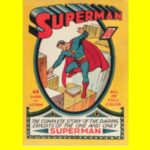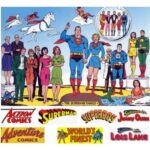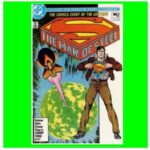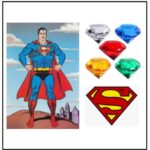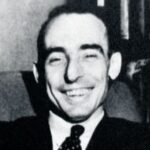Clicking on the following links or images will take you to the different Superman comic collections covered in this section:
Since his debut in the late thirties, Superman has become one of the most iconic comic-book characters, probably the most famous super-hero of all time. His 85-year tenure in comics can be broadly divided into four eras:
- Golden Age (1938 to mid-1958)
- Silver Age (mid-1958 to 1970)
- Bronze Age (1971 to late 1986)
- Modern Age (late 1986 to present)
The exact years covered by these eras may vary slightly depending on the source, but most comic-book experts agree on the following milestones/transition points in Superman’s comic-book career:
The Golden Age began with the introduction of Superman to the world in the landmark Action Comics #1. He had been created several years earlier by Jerry Siegel and Joe Shuster, who had tried to market him before but without success. Superman was a big hit from day one, and over the next two decades his popularity continued to rise exponentially and he became an American institution. The Superman stories in this era are characterized by their everyday plots dealing with gangsters, criminals, corrupt politicians and the like, rather than the supervillains and aliens that would come to be common in later eras.
Over the next two decades after his debut, the Superman legend grew with the fleshing out of his origin story and the introduction of his teenage version called Superboy. Other milestones during this period included the introduction of Kryptonite, an array of Kryptonian survivors and many memorable villains (such as Lex Luthor and Mr. Mxyzptlk). Also, Superman’s secret identity of Clark Kent was given greater prominence: along with his foster parents Jonathan and Martha Kent, his circle of friends expanded (Lois Lane, Jimmy Olsen, Perry White, Lana Lang, etc.). The Golden Age came to a close with Mort Weisinger taking over the editorship of the entire family of Superman comics, marking the beginning of the Silver Age.
Although silver is a less precious metal than gold, in my opinion the quality of Silver-Age Superman comics was far superior to those published in the Golden Age. There was no greater joy in my childhood than reading the Superman comics of the Silver Age. During this period, there were altogether seven comic-book titles featuring Superman (Action Comics, Adventure Comics, Jimmy Olsen, Lois Lane, Superboy, Superman and World’s Finest), not to mention the multiple Annuals and Giants that were published on a regular basis with a selection of reprinted stories from the Golden Age or the early Silver Age.
The mythology of Superman stories created during this era was as grand as any epic such as the Ramayana or Mahabharata. More than anyone else, the person responsible for creating this amazing mythology was Mort Weisinger. During his tenure as editor, Weisinger assembled an incredible team of writers and artists who gave life to his vision of Superman as a three-dimensional human being rather than the cardboard-cutout character he was depicted as during most of the Golden Age.
Under the stewardship of Mort Wesinger, an incredible number of plot innovations were introduced to build the Superman legend, including: the Fortress of Solitude, Brainiac, the Bottle City of Kandor, Supergirl, the Phantom Zone, Lori Lemaris (and many other ‘LL’ ladies), Superman robots, Bizarro, Lex Luthor’s backstory, the planet Lexor, the Legion of Super-Heroes, Krypto and other super-pets, and the Virus X storyline. For the first time, a serious attempt was made to develop consistency and continuity in a comic-book character’s history. Added to the mix were imaginary stories, 3-part novels (full-length comic stories) and giant collections of reprinted stories from the past. All these changes produced a much tighter, more fan-oriented, version of the Superman mythology. For more details on the Silver Age of Superman Comics, please see this link.
The end of the Silver Age came in 1970 with the retirement of Mort Weisinger. No man has presided over more of Superman’s adventures or had a greater influence on the Superman mythos than Weisinger. With his retirement, control over the Superman family of comics passed to Julius Schwartz, another comic-book icon who was responsible for the revamping of many DC super-heroes like the Flash and Green Lantern in the 1950s and Batman in the 1960s. Julius Schwartz (affectionately known as ‘Julie’) took Superman in a whole new direction.
The Bronze Age began with a ‘New Superman’ introduced at the beginning of 1971. This included an attempt to scale back Superman’s powers while removing kryptonite as an overused plot device. To put it bluntly, the ‘New Superman’ was a flop with readers, and by the end of 1971 Superman went back to pretty much the way he was before. However, there were some changes which stuck, such as the transition of Clark Kent from a newspaper reporter to a TV newscaster. Some other milestones which took place during the Bronze Age were the introduction of Darkseid, the enlargement of Kandor and the modernization of Luthor (with a fancy new uniform).
The Bronze Age came to a close in 1986, with the retirement of Julius Schwartz as well as the revamp of the entire DC multiverse with the crossover series Crisis on Infinite Earths. For Superman, the end of this era was marked by the landmark two-issue storyline written by Alan Moore: Whatever Happened to the Man of Tomorrow? For more details on the Bronze Age of Superman Comics, please see this link.
By late 1986, Superman was ready for another reboot. This time, it happened with the 6-issue comic series The Man of Steel by the acclaimed comic-book writer and artist John Byrne, which represented the start of Superman’s Modern Age. This reboot was a lot better than the abortive one in 1971, and this time it would stick for a much longer time than the previous reboot. However, this new version of Superman also gave way eventually to many other reboots over the years, so that it is now hard to figure out which Superman incarnation is being portrayed in the comics.
During the Modern Age, DC’s super-heroes including Superman became darker and more psychologically complex. Comic-book creators became better-known and more influential in the industry, and independent comics flourished and became the primary mode of distribution for comic books. The Superman comics of this era began to do away with many of the campy elements of the Superman mythos and reinvented his story in many ways. This reinvention went through many gyrations and was not always consistent. So DC did another reboot in a 2011 with the Flashpoint crossover series and relaunched all of its super-hero characters in the ‘New 52‘ comic books. Since then, there have been even more reboots of the DC universe, but I have lost interest in following these and have stopped keeping track.
Some notable storylines which took place during the Modern Age were The Death of Superman, one of the best-selling comic stories of all time (followed by World without a Superman and The Return of Superman), Superman for All Seasons, Superman: Secret Origin, and Superman: Earth One. For more details on the Modern Age of Superman Comics, please see this link.
Over the years, starting in the Silver Age and continuing through the Bronze Age and into the Modern Age, many giants and special issues were published. They started with 80-page Annuals and Giants, which reprinted many fan-favorite stories from the past. These later transitioned into 64-page Giants. Eventually, there were 64-page Annuals that featured original stories, as well as a set of special issues with Superman co-starring with other characters such as Spider-Man, Wonder Woman and even real-life heroes like Muhammad Ali! The Modern Age saw the arrival of ‘trade paperbacks’ which collected recent comics that were published as part of a series; these are also referred to as ‘graphic novels’, and sometimes they are published directly rather than first appearing in individual comics.
There have been some amazing writers and artists that produced Superman stories through the various eras. I have some personal favorites among these, who all did most of their Superman work in the Silver Age. These luminaries are Jerry Siegel, Edmond Hamilton and Jim Shooter (writers), and Curt Swan and Neal Adams (artists).
As the co-creator of Superman, Jerry Siegel had already firmly established his name in history, but in addition he played an important role in creating the rich mythology of Superman’s Silver Age. Siegel was a prolific writer who scripted many beautiful human-interest stories which have stood the test of time. Then there was Edmond Hamilton, an accomplished science-fiction author in the thirties and forties who brought his amazing skills to the art of comic-book writing. Hamilton specialized in scripting heroic tales that fill you with a sense of wonder, often in the form of imaginary stories or 3-part novels. Finally, there was Jim Shooter, a child prodigy in the comics world who started scripting many amazing stories (even sketching layouts for the artwork) at the tender age of 13! It was Mort Weisinger who brought together all this incredible talent to create some truly remarkable Superman stories in the Silver Age.
The person most responsible for the modern conception of Superman was Curt Swan, the quintessential Superman artist. He was a superlative artist whose depiction of Superman was more heroic and noble than any other artist’s, before or since, and I consider him the greatest Superman illustrator of all time. While many artists usually pencilled and inked their stories, Swan was mostly a penciller whose drawings were inked by others. In addition to drawing many superb Superman stories, he also drew the vast majority of covers for the entire family of Superman comics during the Silver Age, with the able assistance of inkers Stan Kaye, George Klein and Sheldon Moldoff.
In the late 1960s, several new artists entered the scene, of whom the most remarkable was Neal Adams. His specialty was drawing covers that were simply stunning and guaranteed to arrest your attention. Other than drawing those fantastic covers, Adams did not draw many interior Superman stories; however, he was a regular story artist for other DC characters such as Batman and Green Lantern, and he won many awards for his work on those titles.
For more information on the various Ages of Superman comics, please see this link.

